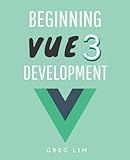Best Vue.js Directive Guides to Buy in January 2026

Vue.js 3 for Beginners: Learn the essentials of Vue.js 3 and its ecosystem to build modern web applications



Master Vue.js in 6 Days: Become a Vue.js Expert in Under a Week



Vue.js 3 Design Patterns and Best Practices: Develop scalable and robust applications with Vite, Pinia, and Vue Router



Getting to Know Vue.js: Learn to Build Single Page Applications in Vue from Scratch



Vue.js in Action



Building Real-World Web Applications with Vue.js 3: Build a portfolio of Vue.js and TypeScript web applications to advance your career in web development



Front-End Development Projects with Vue.js: Learn to build scalable web applications and dynamic user interfaces with Vue 2



Fullstack Vue: The Complete Guide to Vue.js



Beginning Vue 3 Development: Learn Vue.js 3 web development


Vue.js is a popular JavaScript framework that offers a set of useful directives to manipulate the DOM dynamically. Two commonly used directives in Vue.js are v-if and v-show, which allow developers to conditionally render elements in the user interface.
The v-if directive is used to conditionally display or hide an element based on a given expression's truthiness. If the expression evaluates true, the element will be rendered and added to the DOM. Conversely, if the expression evaluates false, the element will be removed from the DOM. This directive provides complete control over whether an element and its child components should be displayed or not.
On the other hand, the v-show directive also conditionally controls the visibility of an element based on a given expression. The difference is that even if the expression evaluates false, the element itself will still be present in the DOM but with its CSS property display set to none. This allows for quicker toggling of visibility, particularly for frequently toggled elements.
To use these directives, you can simply add them to an element as attributes. For example:
In the above examples, isVisible is a property or variable defined in the Vue instance's data or computed properties. The value of isVisible can be dynamically updated based on user interactions, asynchronous operations, or any other logic in your application.
Both v-if and v-show can be used interchangeably in most cases, but they have slightly different use cases. If the element's visibility is likely to change frequently, v-show is usually preferred for its performance advantage. On the other hand, if the element's visibility is unlikely to change or there are complex conditions, v-if provides more fine-grained control.
By utilizing these directives, developers can easily implement conditional rendering in Vue.js applications, improving flexibility and interactivity in the user interface.
How to conditionally hide an element using v-show in Vue.js?
To conditionally hide an element using v-show in Vue.js, you can use a JavaScript expression that evaluates to a Boolean value.
Here is an example of how to conditionally hide an element using v-show:
<div v-show="showElement">
<!-- Content to be conditionally shown/hidden -->
</div>
In this example, the showElement property is initially set to true, so the element will be visible when the page is first rendered. When the "Toggle Element" button is clicked, the toggleElement method is called, which updates the showElement property to its opposite value, thus hiding or showing the element based on the new value of showElement.
How to show or hide elements based on user input in Vue.js using v-if or v-show?
To show or hide elements based on user input in Vue.js using v-if or v-show, you can follow these steps:
- Define a data property to hold the user input. For example, you can define a data property called showElement and set its initial value to false.
data() { return { showElement: false } }
- Use a form element or input field to capture the user's input and update the data property. You can use the v-model directive to bind the input value to the data property. For example, you can use a checkbox as follows:
- Use the v-if or v-show directives to conditionally show or hide the element based on the data property value.
- Use v-if if you want the element to be completely removed from the HTML when the condition is false.
- Use v-show if you want to keep the element in the HTML but hide it by applying the display: none CSS property when the condition is false.
- The element will now be dynamically shown or hidden based on the user's input through the v-if or v-show directive.
What are the best practices for using v-if and v-show in Vue.js?
When using v-if and v-show in Vue.js, it's essential to follow some best practices to ensure efficient and effective usage:
- Use v-if when the condition will rarely change, and the content is not frequently toggled. It completely removes or adds the element in the DOM, which is useful for heavy components, but incurs a higher initialization cost.
- Use v-show when the condition may change frequently and the content is frequently toggled. It uses CSS to toggle the element's visibility without removing it from the DOM, resulting in faster and more lightweight updates.
- Prefer v-show by default, as it generally provides better performance due to the avoidance of full re-renders. Only use v-if when the conditional rendering is rare or when the component is expensive to initialize.
- Use v-if with Vue's tag when you need to conditionally render multiple elements. The tag won't render anything in the DOM itself but will conditionally render its children based on the v-if condition.
- Avoid toggling both v-if and v-show on the same element, as they have different behavior. v-if will completely remove the element from the DOM, while v-show will toggle the element's visibility. Choose one based on the specific requirements.
- Keep performance in mind when using v-show with expensive components. Although it avoids re-rendering the component, it doesn't prevent the component from being initially rendered and initialized. So if the component is heavy, consider using v-if to avoid the overhead of initializing the component.
- If both v-if and v-show are used in the same component, remember that v-if will always take priority. If the v-if condition is false, the element won't be rendered, regardless of the v-show value.
- Be cautious when using v-show with large lists or tables that have many rows. Even though v-show doesn't remove elements from the DOM, it can still impact performance if there are numerous elements to render and update.
By following these best practices, you can effectively utilize v-if and v-show in Vue.js applications, optimizing performance and conditional rendering based on your specific needs.
How to use v-if and v-show with lists or arrays in Vue.js?
In Vue.js, you can use v-if and v-show with lists or arrays by applying them to individual items or elements within the list. Here's how to use them:
- Using v-if: With v-if, the element will only be rendered if the condition evaluates to true. You can use v-if on individual elements inside a loop to conditionally render specific items based on a certain condition. Example usage:
- {{ item.name }}In this example, only the items where item.isVisible is true will be rendered.
- Using v-show: With v-show, the element will be rendered always, but its CSS display property is toggled based on the condition. You can use v-show on individual elements inside a loop to show or hide them based on a condition. Example usage:
- {{ item.name }}In this example, the items will always be rendered, but the ones where item.isVisible is false will be hidden using CSS.
Note: If you have a large list or array where most of the items will be hidden, it is recommended to use v-if instead of v-show as it avoids rendering the hidden elements, leading to better performance.
How to use v-if and v-show with forms in Vue.js?
To use v-if and v-show with forms in Vue.js, you can follow these steps:
- First, create a new Vue instance using the new Vue({}) syntax.
- In the data option of the Vue instance, define a boolean variable to control the visibility of the form. For example, you can use showForm: true to initially show the form.
- In your HTML template, use the v-if directive to conditionally display the form based on the showForm variable. For example:
- Alternatively, you can use the v-show directive to conditionally show/hide the form, which keeps the form in the DOM but toggles its visibility. The usage is similar to v-if:
- In your Vue methods or computed properties, you can modify the showForm variable to control the visibility of the form based on different conditions.
By using v-if or v-show with forms, you can easily show/hide the form based on certain conditions, providing a dynamic user interface in your Vue.js application.
How to use v-if and v-show for conditional styling in Vue.js?
In Vue.js, you can use either v-if or v-show directives for conditional styling. However, there is a subtle difference between them.
v-if will completely remove or add the element from the DOM based on the expression's truthy or falsy value. This means that if the expression is false, the element will not be rendered in the DOM at all. If the expression becomes true later, the element will be added to the DOM.
On the other hand, v-show will toggle the element's CSS display property based on the expression. If the expression is false, display: none will be applied, hiding the element from view, but it will still exist in the DOM and retain its state. If the expression becomes true later, the element's display property will be restored, making it visible again.
Here's an example to illustrate the usage of v-if and v-show for conditional styling:
In the above example, the v-if directive is used to conditionally render the <p> element with the class message. If the showMessage data property is true, the element will be displayed; otherwise, it will not be present in the DOM.
On the other hand, the v-show directive is used to toggle the visibility of the <p> element with the class button. If the showButton data property is true, the element will have its display property set to block, making it visible. If showButton is false, it will have display: none, hiding it from view but retaining its place in the DOM.
You can further use methods or computed properties to update the values of the data properties and control the conditional rendering or styling based on specific conditions or user interactions.
What is the recommended approach for using v-if or v-show in Vue.js?
The recommended approach for using v-if or v-show in Vue.js depends on the specific scenario and requirements of your application.
- Use v-if when you need conditional rendering, i.e., when you want to conditionally include or exclude an element/component from the DOM based on a condition. With v-if, the element/component is completely removed from the DOM when the condition is false. This is useful when the condition is not expected to change frequently and there is a significant DOM manipulation involved.
Example:
- Use v-show when you need to toggle the visibility of an element/component. With v-show, the element/component is always rendered in the DOM, but its CSS display property is toggled based on the condition. This is useful when the element/component is expected to be frequently toggled and you want to preserve its state (e.g., form input values).
Example:
In general, if you need to frequently toggle the visibility of an element, it is more performant to use v-show as the element is not repeatedly added and removed from the DOM. However, when the condition is unlikely to change, v-if may be more efficient as it completely removes the element from the DOM, reducing memory usage.
